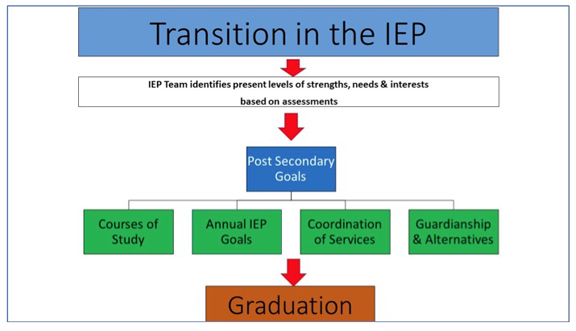Transition happens many times in your child’s life. It happens any time your child moves from one stage of life to the next. When it comes to the IEP, however, “transition” addresses a specific life stage and puts a plan in place for how your child will make that move. Transition in the IEP helps your child move from public school to post graduation and adult life. Transition planning begins to create a plan for the future.
- What will your child do after high school?
- Will your child work?
- Will the student attend college, vocational school, or some other post-secondary training?
- What supports will your child need?
- Who will provide the supports?
Whether your child is in pre-school, junior high, or high school, it is neither too early nor too late to think about life after high school. We know that thinking about the future can be scary, but the outcomes when you don’t think about it are far more frightening!

Currently IDEA requires transition services to be included as part of the IEP when a child turns 16. In Texas, this age is now 14. Remember, students begin planning their high school courses of study in their 7th or 8th grade year in order to ensure they have the right courses needed to go on to college or work. It should not be any different for students with disabilities. This fact does not mean you cannot begin earlier, and perhaps you should!
According to IDEA §300.320, the IEP must:
- Be based upon completed, age appropriate, transition assessments.
- Include coordinated, measurable, annual, postsecondary goals (this is an outcome, not a process, that will occur after your child leaves high school – after graduation
- Include transition services (including courses of study) needed to assist your child in reaching those goals.
Effective September 1, 2018, transition planning for students must address:
1) the use and availability of appropriate opportunities to assist the student in developing decision-making skills and
2) supports and services that foster the student’s independence and self-determination, including a supported decision-making agreement.
What Parents Need to Know
Planning for your child’s transition from high school is really a life-long process. Every ARD meeting you attend should have an eye to the future, to the possibilities for your child, to what the adult world has to offer and will require. Unfortunately, that’s not always what happens; it’s easy for transition planning to become just another checkbox in the ARD meeting. As the parent, you can help ensure that transition planning is all that it should be.
Transition planning is an integral part of the overall IEP. It is not a separate document or a separate process. It is not an afterthought after the rest of the IEP has been created. Transition planning should guide the creation of the rest of the IEP.
Your child should always be involved in transition planning to the greatest extent possible. Preparing for transition is an important time to work on self-advocacy skills(introducing and advocating for oneself) and to get ready mentally and emotionally for life after high school.
Transition planning begins with gathering information regarding a student’s current strengths, needs, preferences and interests.
Transition planning should consider all aspects of life after high school as possibilities for your child. There is a wide range of options. You may have to think creatively to make some of them a reality for your child, but be careful not to let any disability issues keep you from considering all the choices. Among those options: post-secondary education (4-year University, community college, vocational training, adult education), adult services, employment, self-employment, community life, volunteer opportunities, and independent living. What does your child want to do after high school? What do ARD team members envision? As the parent, what is your vision for your child?
Transition planning is exactly what it says…planning. The ARD committee comes to a shared vision with the student and his/her family and creates a plan for getting there. Those plans become reality through the course of study and goals and objectives written into the IEP as transition services.
Far too many students graduate to their living room couch, where their worlds become lonely and limited. Transition to the adult world is what you and your child make it. Look ahead and make a plan for the future!
See also:
Age of Majority/Guardianship & Alternatives
Transition Assessments:
Transition Assessments – Student Centered Transition Network
Age Appropriate Transition Assessment – Toolkit by National Technical Assistance Center on Transition (NTACT)
Transition Assessment Matrix – Indiana Secondary Transition Resource Center
Transition Assessment Reviews – Transition Coalition Univ. of Kansas
Transition Assessments for Students with Significant Disabilities – Transition Coalition
Transition Assessment & Goal Generator – Zarrow Center for Learning Enrichment
Age Appropriate Assessments (video) – Ed O’Leary of Cutting Edj Resources
Health Care Transition Readiness Assessment tool (TRAQ) – Florida HATS (pdf)
Health Care Transition Readiness Assessment for Youth & Families – Got Transition
Charting the LifeCourse – LifeCourse Toolkit
Additional Resources:
CCSSO – College and Career Readiness Standards and Researched-Identified Transition Skills (pdf) needed to obtain employment or participate in further education after high school with sample goals related to curriculum.
Texas College and Career Readiness Standards – See the Cross Disciplinary Standards with Performance Indicators.
Transition Planning in the Federal Law (pdf) – IDEA, State Law & Rule
Visual Transition Plan (pdf) – Thank you to whoever provided us with this document.
Zarrow Center (University of Oklahoma) – Whose Future Is It Anyway? (2nd Edition), by Dr. Michael Wehmeyer, helps prepare students for their IEP meetings and gain self-determination skills (free download)




